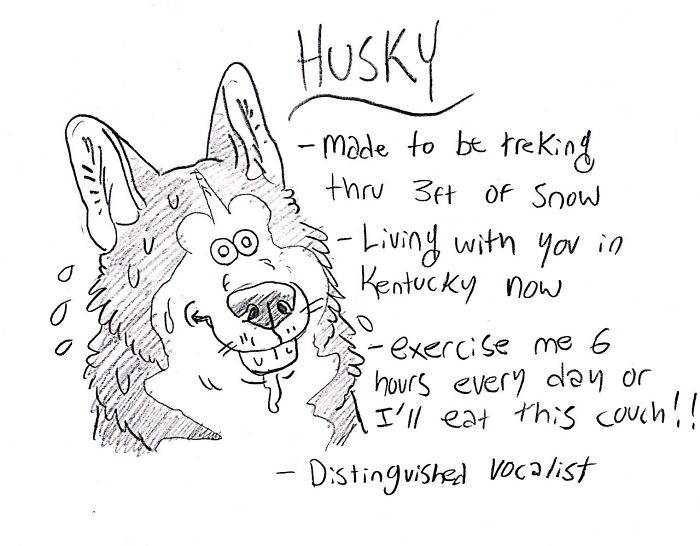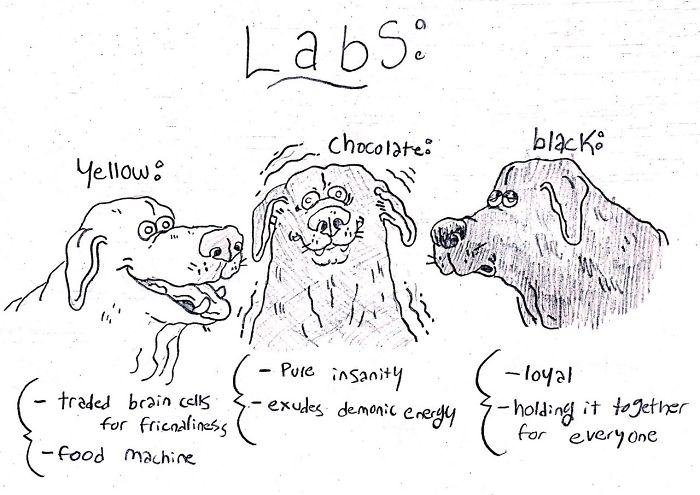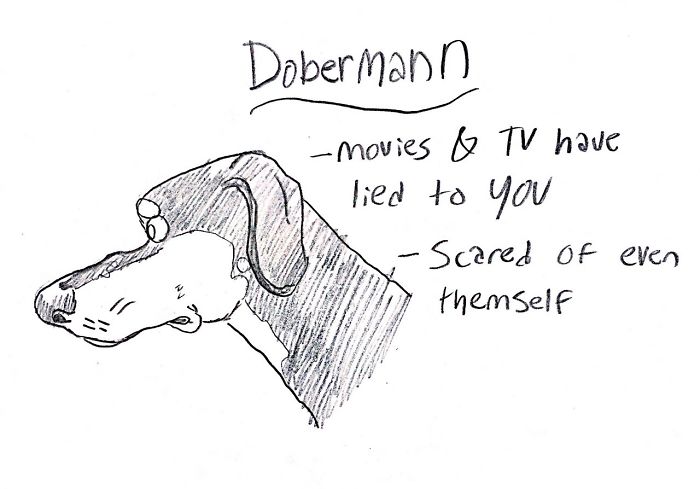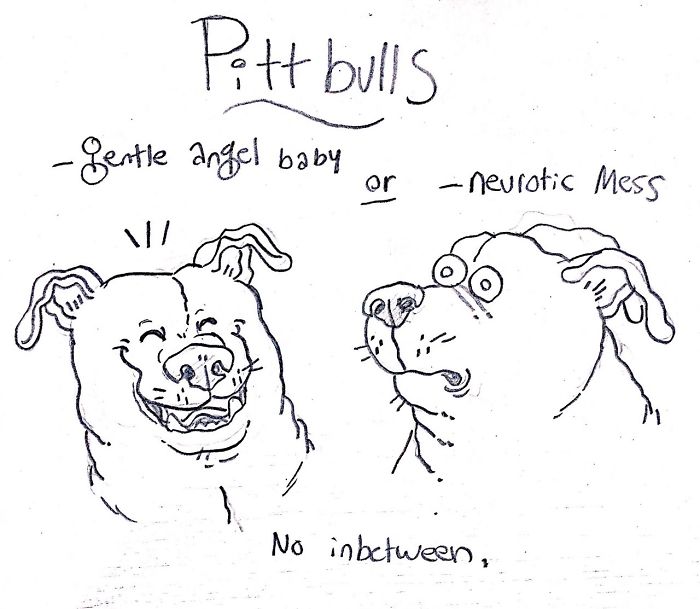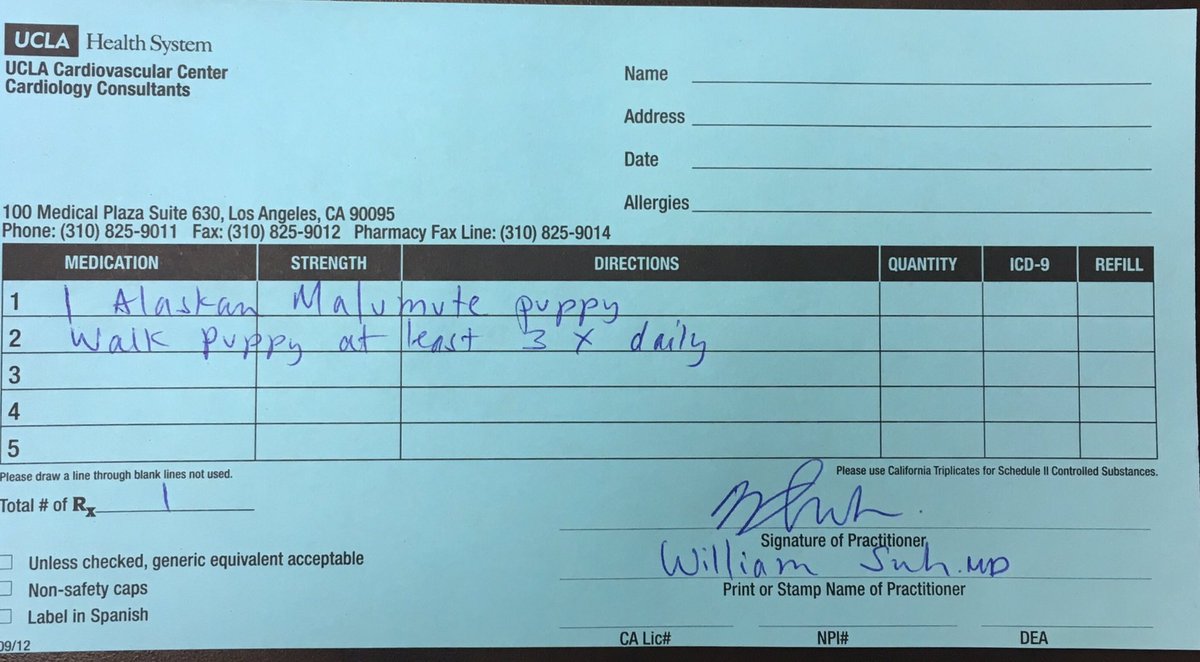Angel Fund Helps Trojan
One day last October, Yolanda Magallanes, took Trojan, her four-year-old pit bull mix, to get some exercise in the park across the street from her Fountain Valley home as she frequently does. All went well until it was time to go home.
“He didn’t want to walk,” Yolanda said. “He didn’t want to go anywhere.” And when they entered her house, he defecated on the floor. “That was not normal for him. I figured he had a little tummy ache.”
When she went to bed that evening, Trojan did not come in to sleep with her. “He has done that since day one. He just wanted to lie on the tile floor.” He was lying in the same spot when she got up in the morning.
Before leaving for work, Yolanda called her sister, Irene Caudillo, and asked her to come get Trojan and take him to see her veterinarian, Dr. Mark Malo at Garden Grove Dog and Cat Hospital. She met her sister there. Dr. Malo did not have good news: He said that the dog was in bad shape and might be dying, she said. He wanted to take x-rays and install an IV.
When Yolanda returned a couple of hours later, Dr. Malo said that the x-rays showed a large mass and that Trojan needed surgery. He asked her to take the dog to a specialty hospital.
After what she described as a “royal” welcome for Trojan, the specialty hospital did an MRI and “put me in a room and said the doctor would be in soon to talk to me.” When the doctor entered, Yolanda said, she was told that her dog had a large mass and needed surgery immediately. There was a 65% chance that the mass was cancerous, the doctor said.
The doctor told her: “Your choice is either emergency surgery now or put him down. If you’re keeping him alive, it’ll cost you $6,000 to $8.000 for the surgery. And with the cancer treatments [that follow], you’ll continue to pay.”
Yolanda asked: “Where am I going to get that kind of money? I don’t make that kind of money. I don’t have that kind of money. The doctor said, you might want to consider putting him down. And I said, putting him down is not an option.”
She asked for a few minutes with family members, who were at the hospital “to figure this out.” But the doctor told her, she said, that “we need a decision within the next few minutes.” She felt pressured.
Yolanda began to sign the paperwork that would permit the hospital to euthanize her pet. “But I just couldn’t go through with it,” she said. Irene offered to lend her $4,000, the sum the hospital wanted before the surgery would be performed. After the credit card transaction, Trojan was taken into surgery.
Following the operation, Yolanda was told that the mass was not malignant and that her dog had suffered a ruptured spleen. Today, Trojan is a happy, healthy dog and Yolanda is “almost done paying the money, little by little, that I borrowed from my sister and from my bank.”
When she asked the specialty hospital about finding help for the surgery bill, they mentioned Angel Fund. Yolanda called the fund and was impressed with how she was received. “Angel Fund was very good to me,” she said. “There was no waiting period and the lady I talked to was very nice and very polite. She was great.” She was granted $500. After a call from Dr. Malo, she said, the specialty hospital reduced her bill by 10 percent, more than $800. She also received a grant from another charitable group.
Yolanda did not see her relationship with the specialty hospital as one of trust. “I didn’t feel that they were communicating with me,” she said. The day after she took Trojan home, she took him back to see Dr. Malo.
She is a single mother who has raised two sons, 19-year-old Edward and Michael, 18, without help from their father. Both still live at home. She works for Advance America, a short-term loan company.
What You Likely Don’t Know About Service Animals, but Should
Story at-a-glance
- A service dog is “Any dog that is individually trained to do work or perform tasks for the benefit of an individual with a disability, including a physical, sensory, psychiatric, intellectual or other mental disability”
- Any breed of dog can be a service animal, as can miniature horses
- Service dogs do not require professional training and there are no required ADA certifications for service animals
- People with disabilities are allowed to bring their service animals to all public facilities and private businesses, without providing any type of “proof” of their disability or dog’s “service animal” status
- A service animal may also be denied access if its presence interferes with “legitimate safety requirements,” such as a hospital unit that must maintain a sterile environment
- Service dogs should not be approached, talked to or touched, unless permission is asked for and granted by the dog’s handler
Service dogs provide invaluable support to their owners, alerting them to potentially life-threatening medical problems or offering psychiatric or visual support. While most people will never experience the close bond that exists between service dogs and their owners, most everyone will cross paths with a service dog at some point in their lives.
Despite their prevalence — you’re likely to spot one sooner or later, since service dogs are allowed to accompany their owners virtually everywhere — many misconceptions persist about these generous animals. This is partly because service dogs look like any other dog, which leads some to believe they should be treated like any other dog — which isn’t the case if the dog is “working.”
Also problematic, the U.S. has no centralized process that allows people with disabilities to register service dogs,1 which means, even though service dogs are afforded special rights, there’s a lot of grey area when it comes to how those rights are protected, for both the dogs and their owners.
Clearing up common misconceptions is an important part of ensuring that service dogs and their owners get the respect and protections they deserve.
Service Dogs Are Not the Same as Emotional Support Animals
The Americans with Disabilities Act 1990 (ADA) defines a service animal as, “Any dog that is individually trained to do work or perform tasks for the benefit of an individual with a disability, including a physical, sensory, psychiatric, intellectual or other mental disability. Other species of animals, whether wild or domestic, trained or untrained, are not service animals for the purposes of this definition.”2
Miniature horses have been added as an exception, however, provided they are housebroken, under the handler’s control, can be accommodated by the facility and will not compromise safety regulations.
On the other hand, emotional support animals (ESAs), according to the Fair Housing Act and Air Carrier Access Act (ACAA), can be any species of animal, who must fulfill a disability-related need and whose use is supported by a physician, psychiatrist or mental health professional. ESAs do not have to be trained to perform a particular task and do not qualify as service animals under the ADA.
Service Dogs Are Not Only for the Visually Impaired
Guide dogs for the visually impaired are just one type of service dog. Service dogs can be trained to help people with physical or mental difficulties, including post-traumatic stress disorder (PTSD). If a veteran is experiencing anxiety or stress due to PTSD, for instance, a service dog can be trained to notice the signs and step in to provide calm and comfort.
They may wake a veteran up from nightmares and are also taught specific commands, including “block,” in which the dog stands in front of the veteran to provide for more personal space, and “cover,” in which the dog goes behind the veteran to “watch their back.”3 Other examples of tasks that service animals may perform include:4
| Assisting individuals who are blind or have low vision with navigation and other tasks | Alerting individuals who are deaf or hard of hearing to the presence of people or sounds | Providing non-violent protection or rescue work |
| Pulling a wheelchair | Assisting an individual during a seizure | Alerting individuals to the presence of allergens |
| Retrieving items such as medicine or the telephone | Providing physical support and assistance with balance and stability to individuals with mobility disabilities | Helping people with psychiatric and neurological disabilities by preventing or interrupting impulsive or destructive behaviors |
Not All Service Dogs Are Professionally Trained
Service dogs do not require professional training and there are no required ADA certifications for service animals. While most service dogs come from reputable trainers or organizations that specialize in training service dogs, according to the ADA, “People with disabilities have the right to train the dog themselves and are not required to use a professional service dog training program.”5
That being said, many service dogs undergo about two years of training before they’re ready and will continue to learn and adapt to their owner’s changing needs over time.6 There are also misconceptions about what type of dog can be a service dog; according to the ADA, any dog breed can be a service animal.
In choosing a service dog, personality is often more important than breed; dogs who are fearful or aggressive are not well suited to be service dogs.
Can Service Dogs Ever Be Denied Access?
People with disabilities are allowed to bring their service animals to all public facilities and private businesses. The owners of a business may ask two questions to determine if the animal is a service animal — and only if the need for the service animal isn’t obvious (such as a dog guiding someone who is blind. Those questions are:7
- Is this animal required because of a disability?
- What work or task has this animal been trained to perform?
Beyond this, no further questioning or “proof” is needed. As noted by the ADA, “A public entity or private business may not ask about the nature or extent of an individual’s disability or require documentation, such as proof that the animal has been certified, trained or licensed as a service animal, or require the animal to wear an identifying vest.”8
Generally, service animals are allowed to go where their owners go, but there are a few exceptions in which a business can ask for a service animal to be removed, including if the animal is out of control or not housebroken. A service animal may also be denied access if its presence interferes with “legitimate safety requirements,” such as a hospital unit that must maintain a sterile environment.9
Should You Pet a Service Dog?
One important point to remember is that certain rules of etiquette apply when it comes to interacting with service dogs and their handlers. Generally speaking, don’t interact with them at all; let the dog and the owner go about their business uninterrupted.
Service dogs should not be approached, talked to or touched unless permission is asked for and granted by the dog’s handler, but take no offense if the handler asks you not to interact with the dog — doing so could distract him from his important role, which is to look out for the health and safety of his owner.
Pet Partners at Petco in La Habra
Owning a dog tied to lowering your risk of dying early by 24%, says science
By Sandee LaMotte, CNN
Updated 2:40 PM ET, Tue October 8, 2019

Old Dogs Don’t Die; They Can’t
From: K9 Companion Dog Training
September 3, 2018 at 8:06 PM
Old dogs don’t die; they can’t.
They’ve merely run up ahead; they’re waiting for us just out of sight. Close your eyes late at night and you may smell his musky odor, or perhaps hear his snuffle from the next room. Pay attention and you may feel his nose on your hand or the back of your calf. When your final day comes, you can go on to meet him; he’s never left you and never will, and when you close your eyes for the last time, you’ll open them again to be met with his Bright eyes and wagging tail.
Old dogs don’t die, at least, not those dogs who take the biggest chunks of our hearts with them when they leave us. Those dogs are inextricably part of our souls, and they go with us wherever we are. Though we may not see them, we know they’re there because our heart is still beating; we still breathe, and those of us who have been truly touched by a good dog know our lives really started the day we met them.
Magnificent dogs don’t die. They shepherd our dreams and only allow the good ones through the gates of our consciousness. They watch over us much as they did in life, and that moment when we step just barely outside of death or disaster, it’s because they moved our feet or they stopped short in front of us as they did in life.
You see, a good dog is something only given to a few people. They are a gift from the universe and, though they’re with us only a short time, they never really leave us. They are loyalty and love perfected, and once we are graced with that sort of love we can never lose it. We merely lose sight of it for a time, and that is our fault; for how can love like that ever go away?
It can’t. It can’t, and it never will. For these brave souls trade their hearts for ours, and they beat together beyond sickness, beyond death. They are ours, and we are theirs, for every sunrise and every sunset, until the sun blazes its last and we once again join the stars.
By Leigh Hester,
K9 Companion Dog Training
Port Jervis, NY
Bogus ‘Service Animal Certifications’ Increasingly Being Sold Online
- Service dogs or animals who provide mental, emotional or physical support have made it possible for people with disabilities to live independently, but now, there are websites advertising bogus certification for support animals
- The Americans with Disabilities Act (ADA) says support animals don’t have the same federal protections as service animals, and business owners may ask someone with a disability only two questions regarding their service animal
- Some people purchase vests or certification to identify their animals as needed support without their animal having actual qualifications behind their label — in some cases simply to bring their favorite animal with them into public places
- It’s often obvious when an animal is a bona fide service dog, such as when they’re guiding someone who is unable to see, is in a wheelchair or has trouble with stability or balance, but other times, disabilities aren’t evident
- According to the ADA, there are regulations in place regarding service dogs, such as what to do if someone is afraid of or allergic to service animals, whether restaurants or theaters are exempt, and whether extra fees are allowed
By Dr. Karen Shaw Becker
Service dogs or animals who provide mental, emotional or physical support have transformed the lives of scores of people, as they make it possible for people with disabilities to live independently. Since new laws have sanctioned the public appearance of service animals, the lives of their humans are far easier and less stressful, as Katherine Moore, who is legally blind, can attest.
“When you have a service animal it’s like you are one. When I put my hand on his harness it’s like an extension of my arm … That’s like putting a value on your freedom. How do you do that? How do you say what your freedom is worth? It’s worth everything.”1
Training for service animals is wide-ranging and extensive, which is why Moore says she’s able to live a full life, including working and commuting, just as she did before she lost her ability to see. One of the few organizations in Tennessee that specializes in service dog training, Smoky Mountain Service Dogs (SMSD),2 focuses on training dogs that will be used by wounded veterans. Mike Kitchens, chairman of SMSD, explains:
“Every dog that we have we will take to Harley Davidson and have them start up the motorcycles. We will take them to the baggage area at the airport. Revolving doors. They have to be so environmentally stable because the intent is for that dog to be able to accompany that veteran wherever he goes.”3
Other animals may provide emotional comfort, but they don’t necessarily fall under the same federal protections as service animals. In fact, Dr. Zenithson Ng from the University of Tennessee Knoxville’s College of Veterinary Medicine contends that emotional support animals are pets. They may alleviate symptoms of conditions their humans have, and even be designated by mental health professionals, but still, they’re not considered service animals. According to the Americans with Disabilities Act (ADA):
“While Emotional Support Animals or Comfort Animals are often used as part of a medical treatment plan as therapy animals, they are not considered service animals under the ADA. These support animals provide companionship, relieve loneliness, and sometimes help with depression, anxiety, and certain phobias, but do not have special training to perform tasks that assist people with disabilities.”4
Bogus Service Dog Certifications: ‘There’s No Such Thing’
Where there’s a service, privilege or right, especially when it comes to animals, it seems there’s always people willing to bend the rules. It usually involves money, and selling so-called “service dog certification” to designate animals with qualifications they don’t actually have are no exception. Needless to say, the types of service and support animals are vast and can be confusing. Here’s a chart that summarizes all of the categories.
“It’s major issue for us because we see it all. We really do,” Kitchens says. “You can Google ‘service dog access’ and you will come up with multiple organizations that for $69.95 we will send you a service dog certification. Well, there is no such thing.”5 There’s also no national registry for animals who are designated helpers for humans, Ng says.
For a fee, there are dozens of websites that offer vests for dogs to wear that “certify” them as certified service, emotional support or therapy animals. There’s another reason why some people are willing to purchase vests without their animal having actual qualifications behind their label. WATE.com notes that for some, it’s also a way to bring their favorite animal with them into public places.
Ng, who’s a member of the steering committee on human-animal interaction with the American Veterinary Medical Association (AVMA), says the problem is a hot topic among personnel responsible for governing the situation due to what he terms as an “onslaught” of problems the AVMA has run into recently. He also notes:
“We are so lucky in this society to have this term of emotional support animal and … we really should designate that for the people who need them and the animals that are well behaved in public settings. So when people are taking advantage of the system that’s really hard, it’s disappointing.”6
Service Animals: Training to Perform Their True Function
The ADA acknowledges that it’s often fairly obvious when an animal is merely accompanying someone in a public place as a pet, or if it’s a bona fide service animal; you’ll know the latter is the case if a dog is guiding someone who is either blind or unable to see clearly, or helping someone who has trouble with stability or balance or is in a wheelchair. However, sometimes disabilities are not always visible to bystanders. The ADA, a division of the U.S. Department of Justice, states:
“When it is not obvious what service an animal provides, only limited inquiries are allowed. Staff may ask two questions: (1) is the dog a service animal required because of a disability, and (2) what work or task has the dog been trained to perform. Staff cannot ask about the person’s disability, require medical documentation, require a special identification card or training documentation for the dog, or ask that the dog demonstrate its ability to perform the work or task.”7
Further, service animals are limited to dogs under Title II and III of the ADA, as of March 15, 2011.8 Local laws prohibiting specific breeds of dogs do not apply to service animals.
The ADA states that a “service animal” refers to any dog individually trained to do what is necessary to help someone with a disability, whether it’s physical, sensory, psychiatric, intellectual or mental. It makes clear, however, that emotional support animals, comfort animals and therapy dogs are not in the same category: They’re not service animals. Similarly, the work service animals perform must be related directly to their human’s disability. In addition:
“It does not matter if a person has a note from a doctor that states that the person has a disability and needs to have the animal for emotional support. A doctor’s letter does not turn an animal into a service animal.”9
ADA Facts Regarding Service Animals
An animal may or may not be wearing a special collar or harness. Some, but not all, are certified, licensed and/or have identification papers stating as such; however, they may not be carrying those papers with them. Most service dogs perform jobs most are familiar with, such as Seeing Eye dogs, seizure response dogs and those who alert people with hearing impairments.10
It’s important to note, though, that some local and state governments have special rules for people entering businesses or public places with support animals aside from service dogs, such as emotional support animals, so it’s best to check with these agencies to find out if such ordinances exist. From a page on the ADA’s website, facts regarding service dogs in businesses include:11
•A service animal must be permitted to accompany an individual with a disability to all areas of the facility where customers are normally allowed to go and must not be segregated from other customers.
•Even if an establishment has “no pets” signs posted, service animals, again, are not pets. Further, the ADA requires proprietors of “restaurants, hotels, retail stores, taxicabs, theaters, concert halls, and sports facilities” to change the wording in such postings to accommodate service animals needed by people with disabilities.
•ADA rules supersede local and state laws stating that only guide dogs are admitted to enter a business to assist individuals with disabilities — so refusing to allow other types of service animals violates the ADA. That said, service animals must be under control, and they must be housebroken.
•Businesses are not allowed to charge customers with service animals any maintenance, deposits or cleaning fees, even if such charges are in place for pets. However, if a service dog does damage in, say, a hotel, proprietors can charge the customer with the disability, but only if the hotel’s policy is to charge non-disabled guests for similar damage.
•Taxi companies may object to a service dog accompanying a disabled person getting into their cabs, but refusing to pick someone up for this reason is also a violation, even if the taxi company is privately owned, and they can’t raise the fare.
Service Animals: Sometimes Other Rules Apply
There are dozens of situations regarding service animals in public places, and probably just as many exceptions. For instance, the care and conduct of service animals is the responsibility of the disabled person they’re with — the animal’s owner. Business owners aren’t required to provide food, care or a special location for the animal.
Arguably one of the greatest concerns people have about service animals relates to fear of the animal becoming a threat to themselves or their customers. But fear of animals, dogs included, or allergies to animals are not good enough reasons to refuse service. The business or government entity is expected to find solutions if employees, other customers or travelers are afraid of or allergic to dogs, such as allowing more or even a separated space.12
As for air travel, the rules are different. The Air Carrier Access Act (ACAA) says airlines must allow both service and emotional support animals to travel in the cabin with the people they’re helping. True, the rules for the latter are getting more strict in light of a number of unfortunate animal incidents on flights.
For that reason, WATE News notes, people who want to travel with emotional support animals or psychiatric service animals may be required to supply specific documentation, including proof of their disability and why their animal is necessary, well before their trip.
People with disabilities who want more information regarding special circumstances, including air travel, may also want to check the provisions made under the Fair Housing Act, which can be found on the U.S. Department of Housing and Urban Development site,13 as it includes specifications for service and emotional support animals.
Don’t Shave Dogs in Summer
When Is the Right Time for Euthanasia?
 BEAU
BEAUBeau
My sister and her husband have a really old Schnauzer-mix named Beau. He might even be a real Schnauzer. He’s so old, it’s hard to tell! They took in Beau when a friend in distress couldn’t keep him. The friend had gotten Beau as a puppy when her son was 10 years old, and that son is in his late twenties now, so… Beau is old. He has limited vision, limited hearing, has had several strokes and can’t walk a straight line, and is growing increasingly incontinent. On his bad days, it seems almost cruel that he is being kept alive. He may stagger or not be able to get up, he acts like he doesn’t know where he is and is anxious, and he may just suddenly completely empty his bladder on the carpet while standing still, seemingly unaware he is doing so.
But on his good days, he runs up the hall with the rest of his housemates, eats with gusto, goes outside through the dog door and potties without assistance or a reminder to do so, and enjoys his time on the sofa and in bed with his human and canine housemates. So they are very much afraid that if they call the vet to make a euthanasia appointment on one of his bad days, and he’s having a good day on the day of the appointment, the vet may decline to euthanize, or the staff may make them feel like creeps! In fact, they feel sort of pre-emptively guilty about even just talking about “Beau’s time.” My sister and brother-in-law love Beau and want him to have a good end. But when is the right time?
Chaco and Lena
There is Chaco, one of my former foster dogs. She’s younger than Otto, but has two failing knees and severe arthritis, and her owner lacks the health insurance or budget to pay for two knee surgeries. Her declining mobility has contributed, it seems, to weight gain, which compounds her problems.
Another friend is in a similar position with Lena, Otto’s very first playmate and friend. She has had one ACL surgically repaired, and underwent “conservative management” when the second one tore; her veterinarian says her hips, too, are quite dysplastic, and would have benefitted from surgery. Both hips and both knees, too? Her very devoted owner, my friend, could not have possibly paid for four surgeries – nor could she have gotten or afforded insurance after the first knee injury and x-rays showed the hip problems. Lena is maintained on daily pain medication and various joint supplements, and my friend takes her for frequent drives to places where she can take short, gentle walks. My friend has also been shopping for some sort of wagon or cart she could use to take the 70-pound dog on walks, so she at least can enjoy the changing scenery and odors. Lena, like Chaco, is getting fairly crippled, but is in otherwise good health and appetite. How long can my friends maintain them in this condition?
How to know when to let them go
Super dedicated owners can provide hospice care for dogs, if they are physically and emotionally able and have an appropriate home and time to do so. We ran a great article about this in 2010; it holds up well today. But not everyone has a schedule and home that would permit, as just one example, helping a large non-ambulatory dog outside to potty several times a day.
Not unrelated: Between all my dog-loving friends, I am aware of exactly ONE DOG who died peacefully in his sleep.
I just went looking; here are some links for information on how to know when “the time” is right for euthanasia:
https://www/americanhumane.org/fact-sheet/euthanasia-making-the-decision/
https://www.lapoflove.com/Quality-of-Life/How-Will-I-Know-It-Is-Time
When it is getting close to time to make an appointment for euthanasia, we have some other helpful articles to read. This one is by a long-time contributor to WDJ, trainer Lisa Rodier.
Also, trainer Jill Breitner’s article on what to ask before making an appointment for euthanasia and the companion piece to that article by Dr. Sally J. Foote are excellent sources of information about what you should know in advance.
Which Dog Is Relaxed?
Hilarious Guide To Dog Breeds That Will Help You Choose Your Next Dog
From: BoredPanda
“I’ve been drawing comics since I was a kid,” Grace told Bored Panda. “I absolutely love animals, so that’s usually my focus! I worked as a supervisor at a doggy daycare for years and got to meet lots of dogs. The cartoon dogs featured in this guide are the breeds I met the most of.”
The artist has divided the series into three parts – big, medium, and small dog breeds, so no k9s are left behind. Great Danes? Check. Border Collies, Yorkshire Terriers? Yep. Pugs, Golden Retrievers, and German Shepherds? Yup. “Sadly, I haven’t met every dog in the word yet so that I couldn’t write about them all,” Grace said. “Although I stereotype them, all dogs are wonderful individuals, so I couldn’t possibly pick a favorite breed!”
Among the animals Gogarty owns, there’s one pooch as well. “His Name is Huey, and he is an enigma. We have no idea what kind of breeds he’s comprised of!” Scroll down to meet the dog memes, and remember – even if some traits sound better than others, every dog deserves a to be a pet. Even if it pees all over your new rug.

